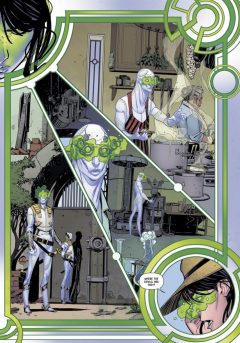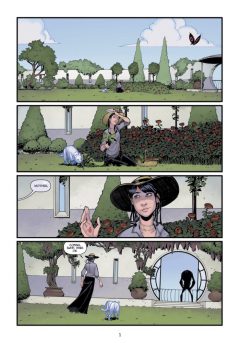Porcelain: Ivory Tower (Improper Books)
 After eighteen months of fevered anticipation, we finally get to see the third chapter of Improper Books’ Porcelain saga. One of the jewels of the UK indie scene, Benjamin Read, Chris Wildgoose and their talented team are back together to bring us Porcelain: Ivory Tower – but can this third volume maintain the magic Porcelain released with its first two instalments or will its success finally shatter?
After eighteen months of fevered anticipation, we finally get to see the third chapter of Improper Books’ Porcelain saga. One of the jewels of the UK indie scene, Benjamin Read, Chris Wildgoose and their talented team are back together to bring us Porcelain: Ivory Tower – but can this third volume maintain the magic Porcelain released with its first two instalments or will its success finally shatter?
 Publisher: Improper Books
Publisher: Improper Books
Writer: Benjamin Read
Artist: Chris Wildgoose (Illustrator), Andre May (Colours), Alexa Rosa (Flatting), Jim Campbell (Letterer)
Price: £14.99 from Improper Books website
Porcelain: Ivory Tower picks up a decade after the events of Bone China as Lady is now Mother, not just to her own daughter Tori and adopted daughter Ari, but also to a whole society of porcelain creations. After a decade of isolation in the titular tower with her creations, Mother’s time appears to have run out as she learns that the rest of the city intend to attack her in retaliation for her past actions. Now Mother, must prepare to defend all of her ‘children’ from the outside forces who want to destroy her world, as well as protect it from those within the walls of the tower who may just be the cause of mother’s undoing.
The Improper books team have once again provided readers with a truly gorgeous title for Porcelain’s third installment. Writer Benjamin Read has crafted a deeply engrossing story which still manages to feel incredibly personal as we follow Mother’s struggle to protect her children (both real and porcelain) against an epic backdrop of political intrigue and, ultimately, war. These struggles see Read shine a a much less sympathetic light on his heroine, as Mother goes through major upheavals that see her evolve from calm leader into a much darker and dangerous persona as a result of both her circumstances and her actions.
Of course, Mother’s story, while being the main focus, isn’t the only character arc in Ivory Tower. Supporting characters, previously hidden in the background during Bone China, step forth to play major roles as Read successfully interweaves their respective stories. Whether it’s Siegfried and Prosper (Mother’s political allies whose allegiance slowly wanes as the book progresses), or daughter Tori (whose apparent teenage rebellion at the start morphs into something more dangerous), these supporting characters give the book added depth and meaning, fleshing out into much more than just a one woman tale.
 However, the key supporting characters are the Porcelain themselves. No longer simple automatons, each Porcelain has a unique look and an equally fascinating personality to go with it. Chief among them is Rowan, whose childlike nature, that was briefly seen in Bone China, is now replaced with something much more confrontational and aggressive. As though he/she is a child rebelling against a parent. Then there’s Hawthorn who despite coming across as a detached scientist, follows Mother and her actions with an almost godlike devotion, occasionally acting like a religious zealot who believes so fervently in her work it may potentially dangerous consequences. And finally, there is Alder, who is portrayed as more like an equal to Mother than a child/follower of his/her peers which leads to a pseudo-romantic relationship between Alder and Mother, and it is this struggle to control him/her which becomes one of the key focuses of the story.
However, the key supporting characters are the Porcelain themselves. No longer simple automatons, each Porcelain has a unique look and an equally fascinating personality to go with it. Chief among them is Rowan, whose childlike nature, that was briefly seen in Bone China, is now replaced with something much more confrontational and aggressive. As though he/she is a child rebelling against a parent. Then there’s Hawthorn who despite coming across as a detached scientist, follows Mother and her actions with an almost godlike devotion, occasionally acting like a religious zealot who believes so fervently in her work it may potentially dangerous consequences. And finally, there is Alder, who is portrayed as more like an equal to Mother than a child/follower of his/her peers which leads to a pseudo-romantic relationship between Alder and Mother, and it is this struggle to control him/her which becomes one of the key focuses of the story.
In fact, control feels like a primary focus for this story. While Read’s foreword refers to this story as one of cost, (which is very heavily implied as many of Mother’s questionable actions come home to roost throughout), the aspect of control comes across as much more significant theme. It is shown in several key moments, particularly through the dynamics that Mother has with the rest of the cast. For example in a key moment with Alder’s, Mother’s need to control things leads her to a dramatic shift in personality, that coincides with control slipping away from her. It’s this subtle yet deep-thoughtfulness which is one of Ivory Tower’s great strengths. But is also a slight flaw as the title seems to have too much content for the book’s size. There is one major moment, in particular, at the end of chapter three that is reduced to quite a small panel compared to the impact it is supposed to convey and undermines what should have been a pivotal moment in the book. That said, given the quality of the rest of the book, and the significant moment that follows it, this is a small price to pay.
 That quality, of course, comes not just from the exquisite story, but from the truly glorious art produced by the talented team of artists. Illustrator Chris Wildgoose once again provides crisp, clean pencils which imbue the story with a very elegant and regal look – befitting the name ‘Porcelain’. But Wildgoose alone isn’t what makes the art great. Colourist Andre May provides a really magical feel during panels when the Porcelain’s alchemic nature emerges in it’s glorious emerald green. While, Alexa Rosa’s flatting does a tremendous job of bridging May’s fantastical colours with Wildgoose’s elegant pencils, helping enhance the overall beauty of the page. Plus there’s, Jim Campbell’s letters which are the final piece of the puzzle and especially shine with the link phrases of Mother’s alchemy or with the depiction of the Porcelain’s words which look beautifully eerie and inhuman. The artwork from this team is visually flawless in the series as a whole, but it really feels like an elevation on this title.
That quality, of course, comes not just from the exquisite story, but from the truly glorious art produced by the talented team of artists. Illustrator Chris Wildgoose once again provides crisp, clean pencils which imbue the story with a very elegant and regal look – befitting the name ‘Porcelain’. But Wildgoose alone isn’t what makes the art great. Colourist Andre May provides a really magical feel during panels when the Porcelain’s alchemic nature emerges in it’s glorious emerald green. While, Alexa Rosa’s flatting does a tremendous job of bridging May’s fantastical colours with Wildgoose’s elegant pencils, helping enhance the overall beauty of the page. Plus there’s, Jim Campbell’s letters which are the final piece of the puzzle and especially shine with the link phrases of Mother’s alchemy or with the depiction of the Porcelain’s words which look beautifully eerie and inhuman. The artwork from this team is visually flawless in the series as a whole, but it really feels like an elevation on this title.
There are many titles in the comic book medium where the word ‘classic’ is used to describe them. However, with Porcelain, this is a description which is more than deserved. With an incredible, deeply enjoyable story and some of the most amazing art in comics today, this is a title that anybody who claims to love comics must find time to read. If you are looking for the definition of an ‘essential read’, then this is it right here.



